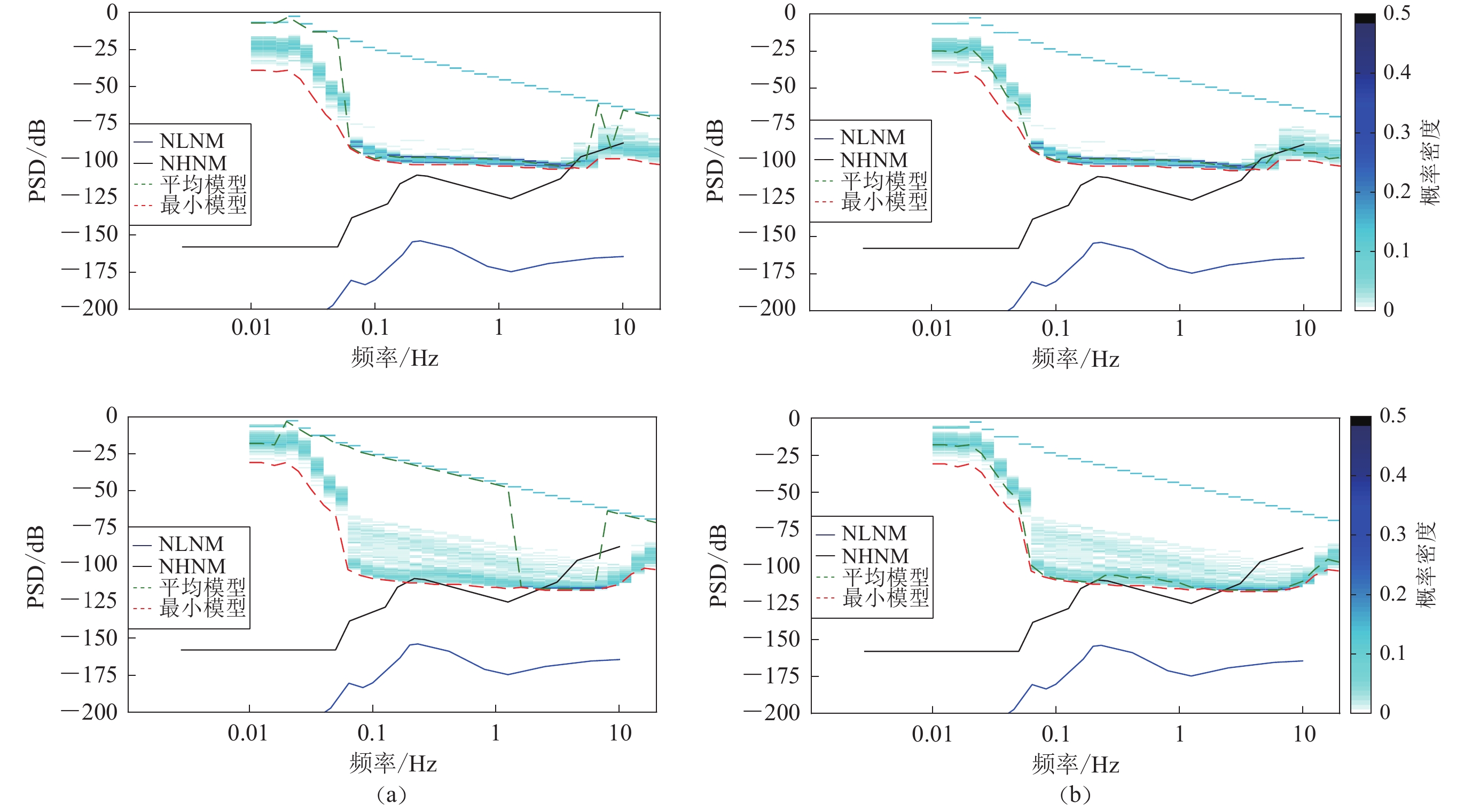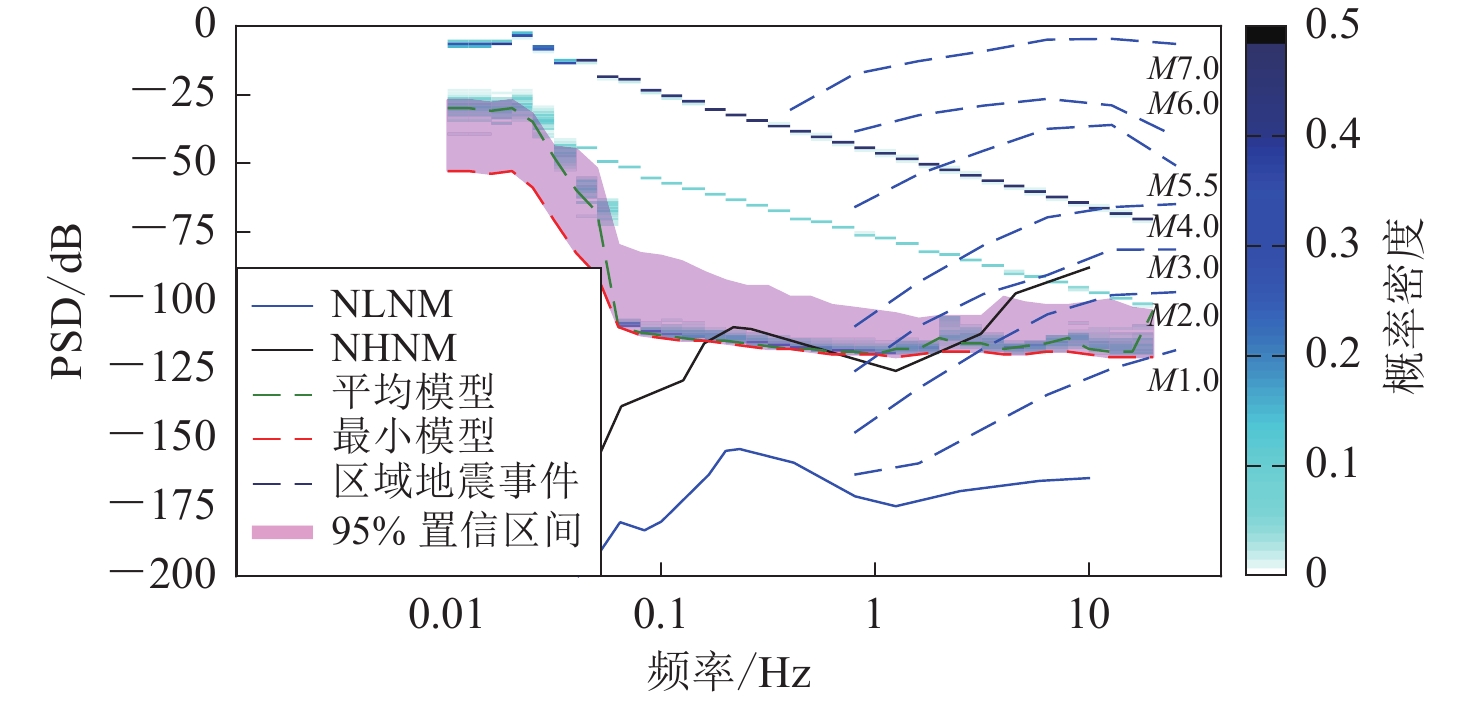Analysis of monitoring capability of strong motion sation based on the probability interval of ambient noise
-
摘要:
本文以珠江三角洲地震监测和预警系统粤东密集台网的强震日常记录数据为基础,利用强震台站背景噪声有效值密度函数,研究强震动台站背景噪声频谱的统计规律,建立强震台站背景噪声有效值平均模型、最小模型以及噪声有效值概率分布区间,通过利用强震台站背景噪声有效值概率分布区间与区域地震事件的频率-加速度幅值分布曲线互比的强震台站监测能力分析方法,得到了不同台站每日背景噪声加速度有效值,并估算了强震台站记录不同震级区域地震事件的概率,来评价台站的监测能力。强震台站背景噪声有效值概率分布区间分析方法是背景噪声有效值概率密度分布分析的延伸和拓展,有助于工程地震学中频率域去噪低端截止频率的讨论。由于仪器自噪声和环境噪声的相互作用不同而导致台站的噪声下限不同,强震台站背景噪声最小模型可以作为该台最优监测能力的估计,是强震仪及观测环境的综合指标。
Abstract:This study is based on the strong motion daily records from the dense network of seismic monitoring and early warning systems of the Pearl River Delta in eastern Guangdong. By utilizing the RMS density function of background noise at strong motion stations, we investigate the statistical characteristics of the background noise spectrum at these stations. We establish the average model, minimum model, and probability distribution interval for the RMS of background noise. This forms the basis for a method to analyze the monitoring capabilities of strong motion stations by comparing the probability distribution intervals of background noise RMS with the frequency-acceleration amplitude distribution curves of regional earthquake events.Using this method, we obtain the daily background noise acceleration RMS for different stations and estimate the probability of recording regional seismic events of various magnitudes, thereby evaluating the monitoring capabilities of the stations. The lower noise limits for different stations vary due to the interaction between instrument self-noise and environmental noise. The minimum model of background noise RMS can be used as an estimate of the optimal monitoring capability of a station, serving as a comprehensive indicator of both the strong motion instrument and the observation environment. This also contributes to discussions on the low-end cut-off frequency for denoising in the frequency domain within engineering seismology. The probability distribution interval analysis method for background noise RMS is an extension and expansion of the probability density distribution analysis of background noise RMS.
-
-
图 1 珠江三角洲地震监测和预警系统粤东密集台网强震观测台站布局及相关地震事件
(a) 区域地震频率-加速度幅值分布模型的地震分布;(b) 台站布局及测试地震分布图
Figure 1. Layout of strong motion observation stations and related seismic events in the eastern Guangdong dense network of the Pearl River Delta seismic monitoring and early warning system
(a) Distribution of earthquakes used to establish the regional earthquake frequency-acceleration amplitude distribution model;(b) Station layout and distribution of test earthquakes
图 2 噪声加速度模型与区域地震事件频率-幅度分布曲线 (Clinton,Heaton,2002) 对比
Figure 2. Comparison of the noise acceleration model with the frequency-amplitude distribution curve of regional earthquake events (modified fromClinton, Heaton,2002)
表 1 台站监测能力评估表
Table 1 Evaluation table of monitoring capability for typical stations
台站 区域地震最优
监测能力区域地震监测
能力 (≥95%)观测环境 台站位置 观测环境影响因素 CNLG 约M2.0 M>4.0 学校教学楼间绿化带内 师生课间活动 CAGHX M>1.0 M>2.0 学校教学楼后面人迹罕至的空地 鲜少人流 HLAJ M>2.0 M≥5.5 村委办公室内 师生课间活动,村委办公活动 CADF M>3.0 M>4.0 学校围墙附近 师生课间活动,校外车辆和人流 CHFX M>3.0 M>4.0 学校围墙附近 师生课间活动,校外车辆和人流 CYGR M>2.0 M≥4.0 学校内,距教学楼3 m 师生课间活动 CYHX M>3.0 M>4.0 潮阳区河溪邮政支局内 工作人员办公活动 DPFL 约M2.0 M≥3.0 学校内,距离教学楼约30 m 师生课间活动 DPGB 约M3.0 M>4.0 学校内,距离垃圾池6 m,距离围墙1 m 师生课间活动 FSHJ M>1.0 M>2.0 学校内篮球场外侧 鲜少人流 HLDL M>3.0 M≥4.0 学校体育馆左侧 师生课间活动 JLJC 约M2.0 M>2.0 学校科技馆内一角,距离围墙1.5 m 师生课间活动 LFJDD 约M2.0 M>2.0 村委办公楼外右侧后方,靠近前边村委围墙旁 工作人员办公活动 LFJDX M>2.0 M≥3.0 村委进大门后右方空地的一角, 工作人员办公活动 CHXN 约M3.0 约M4.0 六合围管理站院内,海边防洪渠旁 工作人员办公活动 CNCD 约M3.0 M≥4.0 学校内,距围墙3米,距教学楼4 m 师生课间活动 CYCN 约M3.0 M>3.0 学校路边的绿化带内,据教学楼6 m 师生课间活动 HJGA 约M3.0 M>3.0 市区幼儿园内,距教学楼3 m 师生课间活动 CAGHD M>1.0 M>2.0 村委院角落 鲜少人流 HLQZ M>2.0 M>3.0 学校教学楼左侧(食堂后方) 师生课间活动 HLZT 约M2.0 M>3.0 学校内,距离教学楼较远 师生课间活动 HDBPZ 数据异常 HJDH LFJS 1 本文涉及地震事件列表
序号 发震时间 M 震中地区 数据类型 目的 年−月−日 时:分 1 2 021−05−21 23:13 3.4 云南漾濞 强震数据 建立地震事件频率-加速度幅值分布模型 2 2 014−07−12 03:21 7.0 本州东海岸近海 强震数据 建立地震事件频率-加速度幅值分布模型 3 2 015−05−30 19:23 8.1 小笠原群岛地区 强震数据 建立地震事件频率-加速度幅值分布模型 4 2 018−09−08 10:31 5.9 云南墨江 强震数据 建立地震事件频率-加速度幅值分布模型 5 2 019−06−17 22:55 6.0 四川长宁 强震数据 建立地震事件频率-加速度幅值分布模型 6 2 019−07−04 10:17 5.5 四川珙县 强震数据 建立地震事件频率-加速度幅值分布模型 7 2 020−01−07 22:09 3.7 甘肃肃南 强震数据 建立地震事件频率-加速度幅值分布模型 8 2 020−03−24 22:39 4.2 青海海西 强震数据 建立地震事件频率-加速度幅值分布模型 9 2 020−06−25 03:47 5.9 本州东海岸近海 强震数据 建立地震事件频率-加速度幅值分布模型 10 2 020−12−24 21:06 3.1 青海兴海 强震数据 建立地震事件频率-加速度幅值分布模型 11 2 021−01−23 09:59 4.8 云南盐津 强震数据 建立地震事件频率-加速度幅值分布模型 12 2 021−02−13 22:07 7.3 本州东海岸近海 强震数据 建立地震事件频率-加速度幅值分布模型 13 2 021−05−21 21:48 6.5 云南漾濞 强震数据 建立地震事件频率-加速度幅值分布模型 14 2 021−05−21 21:55 5.0 云南漾濞 强震数据 建立地震事件频率-加速度幅值分布模型 15 2 021−05−21 21:55 5.0 云南漾濞 强震数据 建立地震事件频率-加速度幅值分布模型 16 2 021−05−21 21:56 4.6 云南漾濞 强震数据 建立地震事件频率-加速度幅值分布模型 17 2 021−05−21 21:56 4.6 云南漾濞 强震数据 建立地震事件频率-加速度幅值分布模型 18 2 021−05−21 22:31 5.2 云南漾濞 强震数据 建立地震事件频率-加速度幅值分布模型 19 2 021−05−21 23:13 3.4 云南漾濞 强震数据 建立地震事件频率-加速度幅值分布模型 20 2 021−05−21 23:23 4.5 云南漾濞 强震数据 建立地震事件频率-加速度幅值分布模型 21 2 021−05−22 02:04 7.4 青海玛多 强震数据 建立地震事件频率-加速度幅值分布模型 22 2 021−05−22 02:28 4.2 云南漾濞 强震数据 建立地震事件频率-加速度幅值分布模型 23 2 021−05−22 09:48 4.2 云南漾濞 强震数据 建立地震事件频率-加速度幅值分布模型 24 2 021−05−22 20:14 4.7 云南漾濞 强震数据 建立地震事件频率-加速度幅值分布模型 25 2 021−05−27 21:06 4.9 青海玛多 强震数据 建立地震事件频率-加速度幅值分布模型 26 2 021−05−27 19:52 4.0 云南漾濞 强震数据 建立地震事件频率-加速度幅值分布模型 27 2 021−06−12 18:00 5.1 云南盈江 强震数据 建立地震事件频率-加速度幅值分布模型 28 2 021−06−16 16:48 5.8 青海茫崖 强震数据 建立地震事件频率-加速度幅值分布模型 29 2 021−06−28 19:48 4.5 云南双柏 强震数据 建立地震事件频率-加速度幅值分布模型 30 2 017−07−15 01:41 3.7 广西南丹 测震数据 建立地震事件频率-加速度幅值分布模型 31 2 017−08−01 06:31 3.0 广西忻城 测震数据 建立地震事件频率-加速度幅值分布模型 32 2 017−08−13 11:10 3.1 广东东源 测震数据 建立地震事件频率-加速度幅值分布模型 33 2 017−08−15 13:16 4.1 广西靖西 测震数据 建立地震事件频率-加速度幅值分布模型 34 2 017−12−08 01:50 1.8 福建龙岩 测震数据 建立地震事件频率-加速度幅值分布模型 35 2 017−12−20 19:07 1.6 广东东源 测震数据 建立地震事件频率-加速度幅值分布模型 36 2 017−12−25 14:48 1.0 广东阳江 测震数据 建立地震事件频率-加速度幅值分布模型 37 2 017−12−29 11:18 1.3 广西博白 测震数据 建立地震事件频率-加速度幅值分布模型 38 2 017−12−29 18:19 1.2 广东信宜 测震数据 建立地震事件频率-加速度幅值分布模型 39 2 017−12−30 12:13 3.4 四川盐源 测震数据 建立地震事件频率-加速度幅值分布模型 40 2 017−12−30 17:06 2.0 广东东源 测震数据 建立地震事件频率-加速度幅值分布模型 41 2 017−12−30 23:11 1.2 广东茂名 测震数据 建立地震事件频率-加速度幅值分布模型 42 2 019−11−25 09:18 5.2 广西靖西 测震数据 建立地震事件频率-加速度幅值分布模型 43 2 019−11−28 07:49 4.6 广西靖西 测震数据 建立地震事件频率-加速度幅值分布模型 44 2 020−06−26 05:05 6.5 新疆于田 测震数据 建立地震事件频率-加速度幅值分布模型 45 2 021−04−02 05:40 3.7 广东东源 测震数据 建立地震事件频率-加速度幅值分布模型 46 2 021−07−02 13:41 2.1 广东连平 测震数据 建立地震事件频率-加速度幅值分布模型 47 2 021−07−19 12:18 1.6 广东东源 测震数据 建立地震事件频率-加速度幅值分布模型 48 2 020−01−20 04:17 4.2 广东丰顺 强震数据 检验地震 49 2 020−05−25 11:24 3.6 广东丰顺 强震数据 检验地震 50 2 020−05−22 22:40 3.3 广东东源 强震数据 检验地震 51 2 020−04−01 22:06 3.2 广东丰顺 强震数据 检验地震 52 2 020−01−20 04:28 3.0 广东丰顺 强震数据 检验地震 53 2 020−03−29 19:31 3.0 广东丰顺 强震数据 检验地震 54 2 020−08−15 13:45 3.0 广东东源 强震数据 检验地震 55 2 020−10−14 12:43 3.0 广东丰顺 强震数据 检验地震 56 2 020−11−25 05:10 3.0 广东河源 强震数据 检验地震 57 2 020−03−28 20:59 2.9 广东丰顺 强震数据 检验地震 58 2 020−04−04 05:22 2.9 广东南澳海域 强震数据 检验地震 59 2 020−09−10 22:17 2.9 广东丰顺 强震数据 检验地震 60 2 020−01−23 20:07 2.8 广东惠来 强震数据 检验地震 61 2 020−02−09 07:47 2.8 广东丰顺 强震数据 检验地震 62 2 020−03−24 12:15 2.8 广东丰顺 强震数据 检验地震 63 2 020−04−04 21:40 2.8 广东河源 强震数据 检验地震 64 2 020−05−25 21:50 2.8 广东丰顺 强震数据 检验地震 65 2 020−07−05 20:01 2.8 广东东源 强震数据 检验地震 66 2 020−12−03 09:18 2.8 广东东源 强震数据 检验地震 67 2 020−04−18 13:30 2.7 广东五华 强震数据 检验地震 68 2 020−10−29 04:48 2.7 广东五华 强震数据 检验地震 69 2 020−02−12 17:04 2.6 广东河源 强震数据 检验地震 70 2 020−06−02 13:22 2.6 广东普宁 强震数据 检验地震 71 2 020−06−04 13:43 2.6 广东东源 强震数据 检验地震 72 2 020−09−10 13:34 2.6 广东丰顺 强震数据 检验地震 73 2 020−12−28 01:10 2.6 广东平远 强震数据 检验地震 74 2 020−02−17 18:12 2.5 广东河源 强震数据 检验地震 75 2 020−03−12 08:17 2.5 广东五华 强震数据 检验地震 76 2 020−03−30 19:49 2.5 广东五华 强震数据 检验地震 77 2 020−02−09 15:40 2.4 广东丰顺 强震数据 检验地震 78 2 020−03−30 01:57 2.4 广东丰顺 强震数据 检验地震 79 2 020−07−30 09:17 2.4 广东东源 强震数据 检验地震 80 2 020−12−12 10:46 2.4 广东河源 强震数据 检验地震 81 2 020−12−15 10:51 2.4 广东丰顺 强震数据 检验地震 82 2 020−02−09 21:53 2.3 广东丰顺 强震数据 检验地震 83 2 020−02−26 06:19 2.3 广东河源 强震数据 检验地震 84 2 020−04−04 21:40 2.3 广东河源 强震数据 检验地震 85 2 020−05−06 04:18 2.3 广东丰顺 强震数据 检验地震 86 2 020−05−07 00:43 2.3 广东五华 强震数据 检验地震 87 2 020−05−27 17:35 2.3 广东丰顺 强震数据 检验地震 88 2 020−06−06 06:37 2.3 广东惠来 强震数据 检验地震 89 2 020−08−08 11:31 2.3 广东东源 强震数据 检验地震 90 2 020−11−28 06:01 2.3 广东丰顺 强震数据 检验地震 91 2 020−03−09 02:14 2.2 广东东源 强震数据 检验地震 92 2 020−08−09 15:46 2.2 广东东源 强震数据 检验地震 93 2 020−08−16 23:27 2.2 广东丰顺 强震数据 检验地震 94 2 020−08−29 22:19 2.2 广东东源 强震数据 检验地震 95 2 020−09−29 02:39 2.2 广东河源 强震数据 检验地震 96 2 020−10−29 05:24 2.2 广东东源 强震数据 检验地震 97 2 020−11−01 04:38 2.2 广东丰顺 强震数据 检验地震 98 2 020−11−09 03:13 2.2 广东龙川 强震数据 检验地震 99 2 020−01−04 06:20 2.1 广东惠阳海域 强震数据 检验地震 100 2 020−02−27 20:14 2.1 广东东源 强震数据 检验地震 101 2 020−05−23 08:50 2.1 广东丰顺 强震数据 检验地震 102 2 020−05−29 07:54 2.1 广东丰顺 强震数据 检验地震 103 2 020−07−06 03:05 2.1 广东东源 强震数据 检验地震 104 2 020−10−14 11:17 2.1 广东丰顺 强震数据 检验地震 105 2 020−11−25 05:13 2.1 广东河源 强震数据 检验地震 106 2 020−12−18 05:58 2.1 广东丰顺 强震数据 检验地震 -
陈魁. 2000. 应用概率统计[M]. 北京:清华大学出版社:23−29. Chen K. 2000. Applied Probability and Statistics[M]. Beijing:Tsinghua University Press:23−29 (in Chinese).
丁莉莎. 2014. 应用于高温环境下的地震传感器关键技术研究[D]. 北京:中国地震局地震预测研究所:64−78. Ding L S. 2014. Research of Key Technology of Seismic Sensors Used in High Temperature[D] Beijing:Institute of Earthquake Forecasting,China Earthquake Administration:64−78 (in Chinese).
丁莉莎,马洁美,齐军伟,谢剑波,廖一帆,卢子晋,叶世山,劳谦,吕仲杭. 2021. 利用背景噪声的分形方法监控台站观测系统运行状态[J]. 大地测量与地球动力学,41(4):436−440. Ding L S,Ma J M,Qi J W,Xie J B,Liao Y F,Lu Z J,Ye S S,Lao Q,Lü Z H. 2021. Discussion on monitoring the operating state of seismic station observation system by using fractal method of background noise[J]. Journal of Geodesy and Geodynamic,41(4):436−440 (in Chinese).
江汶乡. 2015. 面向地震预警的强震动数据处理技术研究[D]. 哈尔滨:中国地震局工程力学研究所:29−34. Jiang W X. 2015. Research on Strong-Motion Data Processing Technology Oriented to Earthquake Early Warning[D]. Harbin:Institute of Engineering Mechanics,China Earthquake Administration:29−34 (in Chinese).
卢大伟,李小军. 2010. 中国大陆强震动观测发展研究[J]. 国际地震动态,(10):35−42. Lu D W,Li X J. 2010. Study on development of strong motion observation in China[J]. Recent Developments in World Seismology,(10):35−42 (in Chinese).
吕永清,蔡亚先,程骏玲. 2007. 确定地震计安装方位的相干性分析法[J]. 大地测量与地球动力学,27(4):124−127. doi: 10.3969/j.issn.1671-5942.2007.04.023 Lü Y Q,Cai Y X,Cheng J L. 2007. Orientation for seismometer with coherence analysing method[J]. Journal of Geodesy and Geodynamics,27(4):124−127 (in Chinese).
王广福. 1986. 地震观测系统的标定与检查[M]. 北京:地震出版社:117−120. Wang G F. 1986. Calibration and Verification of Seismograph Systems[M]. Beijing:Seismological Press:117−120 (in Chinese).
中国地震局. 2017. DB/T 64-2016 强震动观测技术规程[S]. 北京:地震出版社,5. China Earthquake Administration. 2017. DB/T 64−2016 Technical Regulations for Strong Motion Observation[S]. Beijing:Seismological Press:5 (in Chinese).
周雍年. 2006. 中国大陆的强震动观测[J]. 国际地震动态,(11):1−6. doi: 10.3969/j.issn.0253-4975.2006.11.001 Zhou Y N. 2006. Strong motion observation in Chinese continent[J]. Recent Developments in World Seismology,(11):1−6 (in Chinese).
Abd El-Aal A E A K,Soliman M S. 2013. New seismic noise models obtained using very broadband stations[J]. Pure Appl Geophys,170(11):1849−1857. doi: 10.1007/s00024-013-0640-7
Bormann P. 2002. New Manual of Seismological Observatory Practice (NMSOP) Volume 1[Z]. Potsdam:GeoForschungsZentrum:838−960.
Cauzzi C,Clinton J. 2013. A high- and low-noise model for high-quality strong-motion accelerometer stations[J]. Earthq Spectra,29(1):85−102. doi: 10.1193/1.4000107
Clinton J F,Heaton T H. 2002. Potential advantages of a strong-motion velocity meter over a strong-motion accelerometer[J]. Seismol Res Lett,73(3):332−342. doi: 10.1785/gssrl.73.3.332
El Fellah Y,Abd El-Aal A E A K,Harnafi M,Villaseñor A. 2017. New comprehensive standard seismic noise models and 3D seismic noise variation for morocco territory,North Africa,obtained using seismic broadband stations[J]. Explor Geophys,48(3):272−283. doi: 10.1071/EG15053
Gerner A,Bokelmann G. 2013. Instrument self-noise and sensor misalignment[J]. Adv Geosci,36:17−20. doi: 10.5194/adgeo-36-17-2013
Havskov J,Alguacil G. 2007. Instrumentation in Earthquake Seismology[M]. Dordrecht:Springer:1−349 .
Holcomb,L G. 2002. Experiments in Seismometer Azimuth Determination by Comparing the Sensor Signal Outputs with The Signal Output of An Oriented Sensor[R]. New Mexico:U. S. Geological Survey:2−183,206 .
Howard R M. 2002. The power spectral density and its application[C]//Principles of Random Signal Analysis and Low Noise Design:The Power Spectral Density and its Applications. Perth:Wiley:59−91.
Hutt C R,Evans J R,Followill F,Nigbor R L,Wielandt E. 2010. Guidelines for Standardized Testing of Broadband Seismometers and Accelerometers[R]. Virginia:U. S. Geological Survey:2009−1295.
NIED. 2019. NIED K−NET,KiK−net[DB/OL]. [2020−02−08].https://www.doi.org/10.17598/NIED.0004.
Peterson J R. 1993. Observations and Modeling of Seismic Background Noise[R]. New Mexico:U. S. Geological Survey:13−35.
Schorlemmer D,Woessner J. 2008. Probability of detecting an earthquake[J]. Bull Seismol Soc Am,98(5):2103−2117. doi: 10.1785/0120070105
Schultz R,Stern V,Gu Y J,Eaton D. 2015. Detection threshold and location resolution of the alberta geological survey earthquake catalogue[J]. Seismol Res Lett,86(2A):385−397. doi: 10.1785/0220140203
Sleeman R. 2006. Three-channel correlation analysis:A new technique to measure instrumental noise of digitizers and seismic sensors[J]. Bull Seismol Soc Am,96(1):258−271. doi: 10.1785/0120050032
Stehly L,Campillo M,Shapiro N M. 2006. A study of the seismic noise from its long-range correlation properties[J]. J Geophys Res:Solid Earth,111(B10):B10306.
Tasič I,Runovc F. 2013. Determination of a seismometer’s generator constant,azimuth,and orthogonality in three-dimensional space using a reference seismometer[J]. J Seismol,17(2):807−817. doi: 10.1007/s10950-012-9355-y
Welch P. 1967. The use of fast Fourier transform for the estimation of power spectra:A method based on time averaging over short,modified periodograms[J]. IEEE Trans Audio Electroacoust,15(2):70−73. doi: 10.1109/TAU.1967.1161901
Xie J B,Yang D K,Ding L S,Yuan S Y,Chen J T,Lu Z J,Ye S S,Ma J M,Zhao J H,Li X J. 2018. A comparison of azimuth,misalignment,and orthogonality estimation methods in seismometer testing[J]. Bull Seismol Soc Am,108(2):1004−1017.





 下载:
下载:












